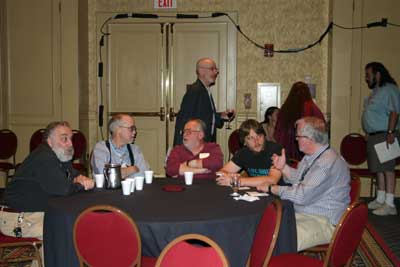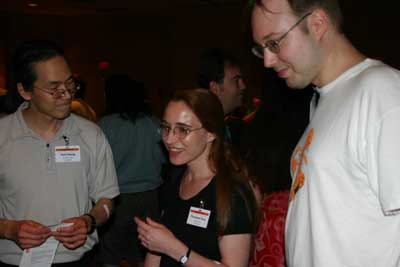Readercon 19 — Friday, 18th July
Today is the first full day of programming. So, here we go….
 11 am Over the Hills in Farah’s Way: Four Categories of Fantasy: Gregory Frost (L), Ellen Asher, Greer Gilman, Sarah Micklem, John Clute. Every Readercon attendee is urged to pick up and devour a copy of Farah Mendlesohn’s Rhetoric of Fantasy, in which she describes four types of fantasy distinguished by the relationship of the protagonists, and hence the reader, to the fantasy world. In the portal-quest fantasy (The Lion, the Witch, and the Wardrobe or Lord of the Rings), the protagonists leave their mundane world and cross through to the fantastic, and the protagonists and reader discover and understand the new world together. In the immersive fantasy (Perdido Street Station or The Iron Dragon’s Daughter), the fantastic is presented without comment or explanation as the norm for both the protagonist and reader. The intrusion fantasy (Dracula or most of Lovecraft’s short fiction) is in many ways the opposite of the portal-quest: the fantastic enters the ordinary world, where it is met by awe, shock, amazement, or the like. (Most intrusion fantasies are horror, but there are interesting exceptions.) In the liminal fantasy (Hope Mirrlee’s Lud-in-the-Mist or Little, Big) there might be an intrusion into the ordinary world, but the reader is disoriented, estranged, or challenged by the casualness with which the protagonists accept the intrusion or by their doubt of its reality. We’ll discuss the usefulness of the taxonomy and look at each of the categories, highlighting the most interesting of Mendlesohn’s insights.
11 am Over the Hills in Farah’s Way: Four Categories of Fantasy: Gregory Frost (L), Ellen Asher, Greer Gilman, Sarah Micklem, John Clute. Every Readercon attendee is urged to pick up and devour a copy of Farah Mendlesohn’s Rhetoric of Fantasy, in which she describes four types of fantasy distinguished by the relationship of the protagonists, and hence the reader, to the fantasy world. In the portal-quest fantasy (The Lion, the Witch, and the Wardrobe or Lord of the Rings), the protagonists leave their mundane world and cross through to the fantastic, and the protagonists and reader discover and understand the new world together. In the immersive fantasy (Perdido Street Station or The Iron Dragon’s Daughter), the fantastic is presented without comment or explanation as the norm for both the protagonist and reader. The intrusion fantasy (Dracula or most of Lovecraft’s short fiction) is in many ways the opposite of the portal-quest: the fantastic enters the ordinary world, where it is met by awe, shock, amazement, or the like. (Most intrusion fantasies are horror, but there are interesting exceptions.) In the liminal fantasy (Hope Mirrlee’s Lud-in-the-Mist or Little, Big) there might be an intrusion into the ordinary world, but the reader is disoriented, estranged, or challenged by the casualness with which the protagonists accept the intrusion or by their doubt of its reality. We’ll discuss the usefulness of the taxonomy and look at each of the categories, highlighting the most interesting of Mendlesohn’s insights.
 The pocket program had a different title but I made it to the panel anyway. I’ve read about one-third of Farah’s book. What I’ve learned from reading so far is that it stops me and makes me think of the fantasy I’ve read and whether most of what I’ve read can be placed in one of her categories. The panel talked about the misfits or outliers to this division. However, John Clute mentioned that all ideas are wrong because you can always find things that don’t fit or don’t fit well, but that an idea that throws light on the subject and is a starting point for discussion and classification is always worth while (I’m paraphrasing so this is my interpretation of what he said). These four ways that the fantastic come into a story are not vertical divisions by more layers or talking points about how the fantastic interacts with the reader and/or the protagonists.
The pocket program had a different title but I made it to the panel anyway. I’ve read about one-third of Farah’s book. What I’ve learned from reading so far is that it stops me and makes me think of the fantasy I’ve read and whether most of what I’ve read can be placed in one of her categories. The panel talked about the misfits or outliers to this division. However, John Clute mentioned that all ideas are wrong because you can always find things that don’t fit or don’t fit well, but that an idea that throws light on the subject and is a starting point for discussion and classification is always worth while (I’m paraphrasing so this is my interpretation of what he said). These four ways that the fantastic come into a story are not vertical divisions by more layers or talking points about how the fantastic interacts with the reader and/or the protagonists.
Whether you agree with the four divisions or not, it is a way to think about fantasy and thus talk about it critically. I really think if you haven’t read the book, do yourself a favor and get it because it will have an impact on how you, as a reader, will relate to and think about fantasy.
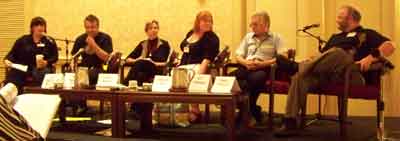 12:00 (noon) Generation Dark: Holly Black (L), Nick Mamatas, M.M. Buckner, Cassandra Clare, Don D’Ammassa, Nathan Ballingrud. There’s some anecdotal evidence that the readership for horror and dark fantasy is younger than the readership for the rest of the field, and this shifting demographic is also reflected in our guest list. To what extent is the boom in young writers and readers of dark fantasy a reflection of the darkness of the times? And to what extent are we simply seeing the first generation to grow up with horror as a successful commercial genre and Stephen King as an icon? What other factors are in play?
12:00 (noon) Generation Dark: Holly Black (L), Nick Mamatas, M.M. Buckner, Cassandra Clare, Don D’Ammassa, Nathan Ballingrud. There’s some anecdotal evidence that the readership for horror and dark fantasy is younger than the readership for the rest of the field, and this shifting demographic is also reflected in our guest list. To what extent is the boom in young writers and readers of dark fantasy a reflection of the darkness of the times? And to what extent are we simply seeing the first generation to grow up with horror as a successful commercial genre and Stephen King as an icon? What other factors are in play?
I found this panel interesting and there was a lot more audience participation. Basically, (my impression was) the youth of today are not newly discovering the dark, all people at times of transition look for the dark in themselves and young people transitioning to adulthood do the same in all eras. The difference is that there seems to be so much more available now with the Twilight series, Buffy, paranormal romance, etc. One phrase I liked is “V.C. Andrews is H.P. Lovecraft for girls.”
The anecdotal evidence turned out to be that because China Mieville brought in a much younger crowd as a guest of honor, young people must like horror and dark fantasy. Laughing commenced and the phrase “anecdotal evidence” became something of a catch phrase.
There was also some anecdotal evidence supplied by the audience that many young people (young teens) don’t know who Stephen King is. Also that young people seem to read a lot of paranormal romance. And that it was the nature of youth to rebel and rebellion often causes them to go and look at the dark within themselves and in the world.
 3:00 pm The Critical Review: Griffin, Gorgon, or Sphinx? David G. Hartwell, Elizabeth Hand, Gary K. Wolfe (L), Farah Mendlesohn, John Clute. The book review and the critical literary study serve fundamentally different purposes. Yet SF book reviews have frequently contained valuable critical insights: it’s hard to avoid having them if you’re a perceptive reader, and hard to leave them out of a review. We’ll look at the history and techniques of the critical review and assess just how comfortably the two components have gotten along. What does the continued practice of the hybrid form say about the nature of the reading experience and the way we talk about books.
3:00 pm The Critical Review: Griffin, Gorgon, or Sphinx? David G. Hartwell, Elizabeth Hand, Gary K. Wolfe (L), Farah Mendlesohn, John Clute. The book review and the critical literary study serve fundamentally different purposes. Yet SF book reviews have frequently contained valuable critical insights: it’s hard to avoid having them if you’re a perceptive reader, and hard to leave them out of a review. We’ll look at the history and techniques of the critical review and assess just how comfortably the two components have gotten along. What does the continued practice of the hybrid form say about the nature of the reading experience and the way we talk about books.
David Hartwell started out when asked about the difference between reviews and critical study, said that reviews are for people who haven’t read the book and want to figure out if they’d like it and critical studies are for people who have read the book. Most of the panel thought that was too limiting (I agree with him). John Clute said he doesn’t care if he gives away the ending because he’s talking about the shape of the book/narrative and you need the ending to see the full shape. Elizabeth Hand said as a reader she always reads the ending first but as a reviewer she reads front to back to give the full experience and surprise of the ending for the reviews. All agreed that reviews/critical studies should be entertaining and enjoyable in themselves.
Then there was some discussion of the growing trend for reviews to be entertainment in and of themselves and books being chosen just as jumping off points to write and entertaining review, usually negative, about the book. Following this the panel members discussed reviewing or reviewers with agendas.
John Clute said that reviewers are essentially essayist and and reviews should have the shape of an essay. Then there was a discussion of word length, essays, protocols, and formats for reviews.
A consensus was reached that reviews should be pleasurable to read in themselves whether or not you intend to read the book. Interesting thought. I still believe that there is a difference between reviewing for people who are trying to figure out if they’ll enjoy a book than writing for people who have read the book who are looking to learn more about the structure and narrative techniques used to create the reading experience.
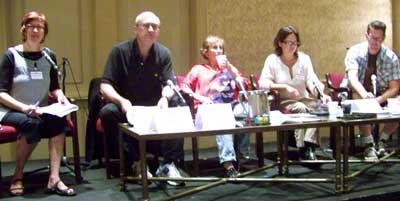 4:00 pm Objects in a Room May be Scarier Than They Appear. Delia Sherman (L), John Clute, Kit Reed, Lucy Corin, Paul Tremblay. “The description in crime fiction of domestic interiors, furnishings and possessions…is often crucial to the plot. In Agatha Cristie, for example, we can be confident that almost any domestic article mentioned, however commonplace, will provide a clue, either true or false.”–P.D. James. Objects in a room in SF or fantasy are clues to the world-building, while in much contemporary fiction they are class and status markers and hence clues to character. What about the objects in a room (and by extension the entire described environment) in a horror or slipstream story? How often are they clues, and clues to what? Or is the very cluelessness of the environment part of what creates the horror or facilitates the slippage.
4:00 pm Objects in a Room May be Scarier Than They Appear. Delia Sherman (L), John Clute, Kit Reed, Lucy Corin, Paul Tremblay. “The description in crime fiction of domestic interiors, furnishings and possessions…is often crucial to the plot. In Agatha Cristie, for example, we can be confident that almost any domestic article mentioned, however commonplace, will provide a clue, either true or false.”–P.D. James. Objects in a room in SF or fantasy are clues to the world-building, while in much contemporary fiction they are class and status markers and hence clues to character. What about the objects in a room (and by extension the entire described environment) in a horror or slipstream story? How often are they clues, and clues to what? Or is the very cluelessness of the environment part of what creates the horror or facilitates the slippage.
The discussion circled round the need for all elements in a story to serve the character(s) or the plot. Everything (objects, character, and plot) join together to form an organic whole. Less is usually more. Write and describe everything you want and then, for every item, ask if it is needed. If you can’t think of at least two reasons to keep it, take it out. You want everything to be there for a reason not to be set decoration.
Bad horror is usually recognized by adjectival barrages — lacking true description. The best horror has no metaphors.
 7:00 pm Waking Up Sober Next to a Story Idea. Kay Kenyon, Jennifer Pelland, Jeffrey A. Carver (L), Paolo Bacigalupi, David Anthony Durham, Allan Steele. Really, it seemed absolutely beautiful once upon a time. Now that you’ve had intimate knowledge of it (say, midway through the novel), you can see all the less-than-flattering sides. You may even wonder, What the hell was I thinking? How do you recover enthusiasm for the work? Now that you see the flaws, how do you begin the process of fixing them?
7:00 pm Waking Up Sober Next to a Story Idea. Kay Kenyon, Jennifer Pelland, Jeffrey A. Carver (L), Paolo Bacigalupi, David Anthony Durham, Allan Steele. Really, it seemed absolutely beautiful once upon a time. Now that you’ve had intimate knowledge of it (say, midway through the novel), you can see all the less-than-flattering sides. You may even wonder, What the hell was I thinking? How do you recover enthusiasm for the work? Now that you see the flaws, how do you begin the process of fixing them?
The trick, said the panel, is recognizing when to stop and give up, put the story on ice for later, or simply toss it out. Consensus was that all writers need a bullet-proof, unshakable, bullshit detector. Sometimes you may know the beginning and the end, but not the middle, sometimes the middle and the end but don’t know where to start — the trick it to connect them anyway. Do you barrel thorough anyway or give it up?
It seems that most of the time if you’re stuck it’s because you lost the heart/essence/theme of the story. Once you find it again, write it down in two sentences or so because it will keep you focused and hopefully avoid another wall. You always need to keep the WHY of the story in mind.
They agreed that the worse thing is when you can see the story and know the potential but you know you can’t live up to the potential — you just can’t pull it off because you lack the skill at this point, but you’re the one who has to do it.
They all mentioned how key a significant other or spouse who believes in you when you’re in the depths of despair can be to keep you believing in yourself. Each told stories of when they hit the wall and lost the heart of a story and had to strive to find it again or just give up and go on.
I’d hoped to go to another panel on writing essays but unfortunately, I needed to eat supper before all the eateries around the hotel closed for the evening. So, food and drink were in order.
Once fed and watered, we ventured to the Meet The Pro(se) party. This is the standard Friday night Big Event at Readercon, where, in an informal setting, everyone gets to mingle and talk. We schmoozed for about a hour, taking a few pictures here, chatting there, being witty and engaging throughout.
But now it’s time to finish writing up this report and getting to sleep. Tomorrow is another busy day.
 |
 |
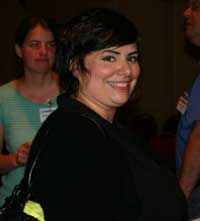 |
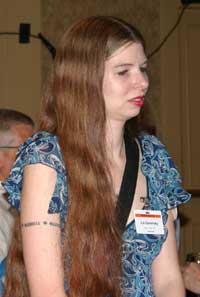 |
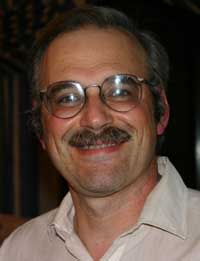 |
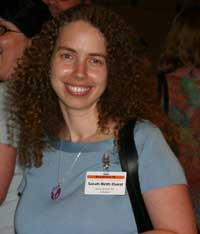 |
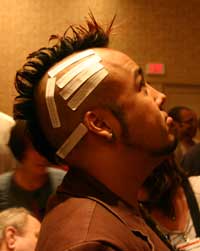 |

